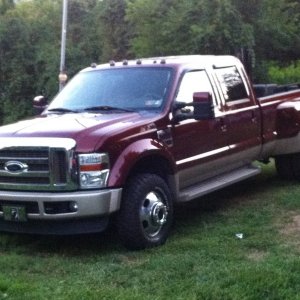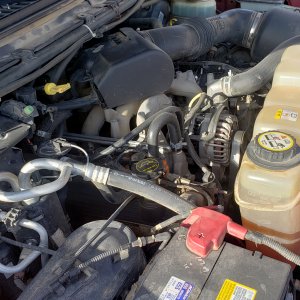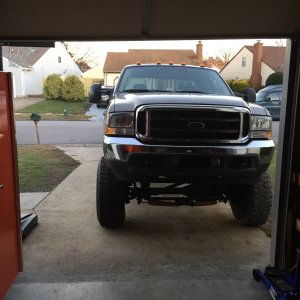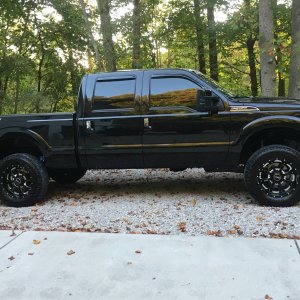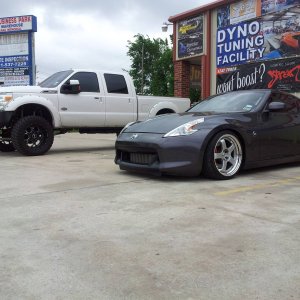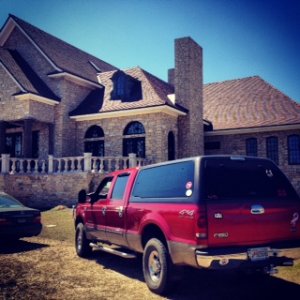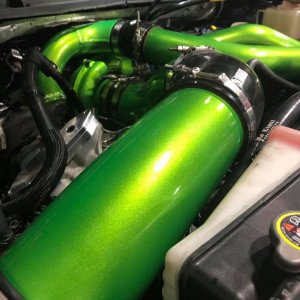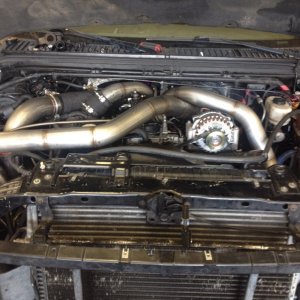heres a good artical that was published jan. 2008
Tensile Strength:
Tensile strength is the most common mechanical property that is referred to when talking about fastener strength. It is the maximum tension-applied load the fastener can support before it fractures.
Fatigue:
Fatigue in a fastener can cause sudden, unexpected failures. A fatigued fastener can fail even when loads are below the strength of the material due to operating under constant cyclic loads. Fatigue strength is often defined as the maximum stress a fastener can withstand for a specified number of repeated cycles before it fails.
Some of the most important fasteners in the engine such as cylinder head bolts, connecting rod bolts and main bearing and cap bolts are subject to fatigue forces. It is important to use fasteners with high fatigue strength, as well as the tensile strength, to hold the joint together under high-pressure forces in these applications.
Torsion:
Torsion strength is typically the amount of torque or friction a fastener can safely handle before it breaks. One thing to remember is that when torque is applied to a fastener, most of the input is spent in overcoming friction. Roughly 85-95 percent of the energy you have spent tightening the fastener is lost, leaving only about 5-15 percent in actual clampload. Because of this, any slight variation in friction can lead to significant changes in resulting preload conditions.
These variables include surface roughness, surface finish, lube, load-range, dimensions, temperature and torque sequence. This is why it’s so important to achieve consistent friction conditions and to use the methods that allow the most consistent torquing. So the preload target will depend on the lube you use (most use a Moly lube or 30 weight oil) and the tightening sequence.
Proof Load:
Each material has a certain amount of elastic range, meaning the fastener can be stretched to a certain point but when the load is released it can return to the original shape. But if the load applied exceeds the elastic range and therefore causes the fastener to go past the yield point, it then reaches what is called the plastic range of the fastener. The fastener material is no longer able to return to original size.
The proof load is an applied tensile load that can be applied before permanent deformation. It represents the useable range of a fastener before it goes into its “plastic range” where it cannot return to its original size and shape. At this point of yield, permanent elongation of the fastener sets in. If you continued to load the fastener, it will reach its ultimate tensile strength in which “necking” or elongation occurs until it is stretched to the point of breakage.
Shear Strength:
Shear strength is the maximum load a fastener can take before it fails when it is applied at a right angle to its axis. A load occurring in one transverse plane is called single shear, while a load that is applied in two planes, where a fastener may be sliced in three pieces, is called double shear.
Materials
Racing applications require high quality, precision tolerance fasteners to achieve the clampload and fatigue strength that is needed in a harsh environment where there are extreme forces placed against them. Materials used to make fasteners vary with the application and load carrying needs.
The most common high-grade material is medium carbon alloy steel that is used in making SAE J429 Grade 8 bolts. These bolts are often used by OEMs in high stress applications and in some racing applications and are rated at 150,000 psi tensile and 130,000 psi yield with a proof load of 120,000 psi.
“One of the issues with Grade 8 bolts is that there are some areas where you really don’t want to use them,” says Doc Hammett, Totally Stainless. “If there’s a cycling load on them you could start to get into trouble. A classic example was on the old belt drives where street rodders were using Grade 8 for accessories and they were breaking bolts all of a sudden. Many were left scratching their heads until someone figured out the bolts were fatigued. The higher the carbon steel the more they are prone to fatigue. Fastener manufacturers add other alloys to carbon steels and change the properties to suit their specific needs. This is one of the most interesting things about steel: you can add a little bit of something and make the properties change drastically.”
Hammett says one of the biggest things that Totally Stainless has done recently is to introduce large high-strength stainless bolts. Stainless steel by definition is anything with at least 12 percent chromium in it. “There are over 1,000 different alloys of stainless,” says Hammett. “What people generally think of is 300 series stainless is generally a low strength material and is not heat treatable. The most common 300 series is an 18-8. It’s 18 percent chrome and 8 percent nickel. The tensile strength for 1/2˝ and larger 18-8 stainless bolts is no more than 80,000 psi and the yield strength is only 45,000 psi. We use 17-4 PH for our high-strength bolts, this material is heat treatable and has a tensile strength of 200,000 psi and a yield strength of 175,000. We electro polish them, which makes them more corrosion resistant.”
Don Trapp of A1 Technologies says his company starts out with the basic alloy 4340 or 8740 that is 190-ksi minimum. From that point it goes up to 280 ksi. “The 4340 or 8740 is already far above an OEM fastener in strength and quality. We use a lot of H11, which is a toolsteel for Top Fuel, Funny Car and some in Top Alcohol and Injected Nitro classes use it also. This is a 240 ksi minimum graded material.”
Trapp says almost every team in the top classes of drag racing uses this bolt material, because these cars are some of the most extreme applications. “As far as boost for superchargers and horsepower, to clamp a head and main studs down on a Top Fuel engine is a pretty extreme proposition. We also use this material quite a bit in Sport Compact classes because they use extreme boost levels in many cases. There are many teams running 60 lbs. of boost on top of high compression, so the cylinder pressures are what you would call extreme.”
The next step up from 4340 or 8740 steel is 1722 (AMS 6304). Manufacturer ARP calls it ARP 2000 and it’s all the same material, a 220 ksi material. The next step would be H11, which ARP calls L19. It too is the same material and also comes from Carpenter. Those are getting up to 240-250 ksi. You can go higher than that but it becomes brittle, according to Trapp.
The next step up include two materials: Custom Made 625 and Aerospace Material Specification (AMS) 5844. Trapp says A1 Technologies gets both materials from Carpenter as well. “The AMS 5844 has a trademark name MP35M, which means it’s multiphase,” says Trapp. MP35N is an age hardenable Nickel-Cobalt base alloy that has a unique combination of properties - ultra high strength, toughness, ductility and outstanding corrosion resistance. MP35N resists corrosion in hydrogen sulphide, salt water and other chloride solutions. ARP calls this material ARP 3.5.
Both of those materials are considered a super alloy and are a very high nickel base. The last two are stainless steels because there’s so much nickel in them. One is mostly nickel and the multiphase is Nickel-Cobalt. Right now the multiphase is about the strongest fastener material out there. But the material alone is $75 a pound before anyone begins making the fastener.
Preload
There is definitely a relationship between torque and preload, but there is some confusion as to the difference. With connecting rods it is not too difficult to use the stretch method and to measure the preload by measuring stretch. But in head bolts it is much more difficult to measure and you’re basically reliant on the torque wrench to stretch the bolt. A torque wrench needs to be recalibrated often and you need very clean threads that have been burnished in so there is very little friction. The preload is the force on the bolt that clamps the joint together. Torque, however, is just the mechanism used to get the desired preload.
Lubricants
There’s a huge difference in torque depending on what type of lube you use, whether it’s engine oil or extreme pressure lube (EPL), which is used quite a bit in NASCAR for instance. Trapp says A1 Technologies doesn’t recommend any particular type of lube. “We normally recommend that the higher the torque is the more efficient lube you use. It’s better for the fastener and the torsional stress. Friction can take up to 80 percent of the torque to overcome so the more you can reduce friction, the less torsional force you put on the fastener and the more effectively you’ll stretch the stud, which is really the goal.”
Head Studs
Generally, when you torque the stud you put a certain amount of stretch on it. The smallest diameter of the stud is where the stretch is going to occur. So if the threads are your smallest diameter, that’s where it will stretch. If you make the body smaller (undercut), then you begin to make the stretch in the body of the fastener be it a stud or a bolt, as opposed to making it occur in the threads. That’s why in a rod bolt, you rarely see one that doesn’t have an undercut. Head studs, depending on the application, you may have an undercut or you may have an in-between or full-body stud.
An in-between doesn’t elongate much while achieving its clampload as opposed to a full undercut stud that will actually elongate a little further. One stud may stretch .005˝ to achieve 20,000 lbs. of clampload. The other one may stretch .0075˝ to get the same amount of clampload.
You can reuse any bolt as long as you don’t get into the yield of the bolt and stay within 80 percent of its yield strength. You can still yield even a very strong fastener so it’s a one time only use fastener. It depends on what you want to design and what torque you utilize.
“There’s a whole world of fasteners out there that engine builders need and that industrial suppliers just don’t have. That’s why we are in business,” says Totally Stainless’ Doc Hammett. Keep this in mind next time you are looking for fasteners for your performance build.
after reading this artical i can see how a-1 can have more clamping force then the arps even with the lower torque value or arp has more then a-1s its a toss up until someone tests it .. i did not realize how much was lost when transfering the torque into the clamping force.. i know the ARPs i have were the ones with ungodly torque now im worried about reusing them.. even tho arp assures me i can, don(a-1) told me in that email that much torque will over stretch it.. the quality of the head studs from arp were insane very good quality and im sure the a-1 studs are also.. pretty much comes down to what you want to put in your truck...

